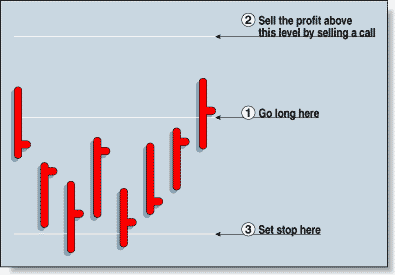OPTIONS
Let Options Pay For Your Stops
by Joe Luisi
Want to get into positions with good risk-return ratios and firm boundaries of gain and loss? Look no further: Here's a technique for having it all -- or most of it, anyway.
You know you should use stops, but they cause losses, don't they? Would you use stops if you could minimize or even erase those losses by selling options? Would stops look better to you then?

FIGURE 1: COST COVERING. When a signal is generated, place your stops in the market. To help cover the cost of being stopped out, sell an out-of-the-money option.
Sooner or later, every trader comes to realize that he needs to use stops. It doesn't matter if you're a short-term trader or a longer-term trader; stops are essential for the preservation of capital. In addition, using a stop makes you be very specific about the point at which you'll admit you were wrong about a trade. But is there a way that you can somehow reduce the costs of stops? Better yet, is there a way to make money even if you get stopped out?
Enter, if you will, the wonderful world of options. Options have become so popular that almost every futures market offers them, and more than 2,000 stocks do as well. I'm going to assume that you have a basic working knowledge of options, and I'll show you how to use them to help cover the costs of your stops.
USING THE YEN
The best way to describe some of these techniques is to look at real-world examples, but my basic idea is as follows: When a signal is generated to buy or sell, place your stops in the market the way you normally would. To help cover the cost of being stopped out, sell an out-of-the-moneyÝ option (Figure 1). This technique is called a covered write. You sell a call if you're long or sell a put if you're short. If the market moves in your direction, you will make money up to the point where the market moves above or below the strike of the option you sold. Beyond that level, the position becomes covered, meaning you will no longer make money, since you have sold that profit to the option buyer.
Look at the yen contract. November 10, 1999, looked like a potential buy setup (Figure 2). The five-period stochastic was above 50 and on a buy signal; in addition, the market closed above its 10-day simple moving average. A possible swing low was in place. With those factors in mind, I wanted to buy on the close at 0.9605.
There were two places for a stop: a tight short-term low, which would be 0.9550, or a wider stop on the swing low, 0.9430. The swing-low stop was too wide with too much potential loss, so I decided to use the short-term low as a stop (0.9550). That made my risk for this trade around 0.9605 - 0.9550 = 0.55 to 0.60 ticks ($625).
Private trader Joe Luisi can be reached at 717 558-6407 or via Internet at https://www.jaltrading.com/. He specializes in consultation and system development for the futures markets and has foreign exchange historical data.
Excerpted from an article originally published in the March 2000 issue of Technical Analysis of STOCKS & COMMODITIES magazine. All rights reserved. © Copyright 2000, Technical Analysis, Inc.
Return to March 2000 Contents